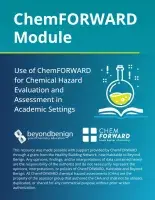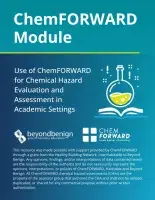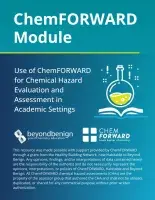This ChemFORWARD module consists of 3-lesson units that aims to help instructors teach students how to use the ChemFORWARD platform to obtain hazard information for specific chemicals, and to identify safer chemicals to replace chemicals of concern in research and in product formulations.
The module is organized into two units. Each unit contains a unit overview, specific learning outcomes, course alignment, prerequisites, lecture slides, assessment/review questions, instructor notes, and a list of additional resources. Assessment/review questions can be used on quizzes, exams, or in lecture. The assessment/review slides can be used as clicker questions for in-class feedback. Assignments could be used as group activities or as homework assignments. CAS Registry Numbers for pertinent chemicals cited in the lecture slides, assignments, and review/assessment questions are listed at the end of this document.
The module also provides background materials on hazard, risk, and chemical alternatives assessment, as well as links to available resources on toxicology.
This module was authored by Mark Mason (Ph.D.), Cynthia Woodbridge (Ph.D.), Heather McKenney (MPH.), Gabrielle Rigutto (M.S.) and Monica Nyansa (Ph.D.) and was reviewed by Julian Silverman (Ph.D.) and Sarah Prescott (Ph.D.).
ChemFORWARD is providing free access for a limited number of 20 classrooms of Green Chemistry Commitment (GCC) Signers for Fall 2024 as part of a pilot program for educational use. Please contact educator@chemforward.org for access to the database to use the module. The module was designed using the beauty and personal care vertical of the ChemFORWARD database. Chemical hazard data (i.e. Hazard Bands, endpoint classifications) presented in ChemFORWARD are the same across all verticals. However, industry-specific data, such as restricted substances lists, regulatory summaries, etc. are curated to each vertical based on industry needs. Therefore, educators may find that content in this module is not generally applicable to industries other than beauty and personal care. For more information about additional industries available for subscription in ChemFORWARD, please reach out to educator@chemforward.org.
The inspiration of this work began with a Forsythia Foundation grant to Habitable (formerly Healthy Building Network) to support Beyond Benign and ChemFORWARD to develop a green chemistry curriculum that leverages from Habitable’s Pharos chemical hazards database combined with ChemFORWARD’s safer alternatives. Any opinions, findings, and/or interpretations of data contained herein are the responsibility of the author(s) and do not necessarily represent the opinions, interpretations, or policies of ChemFORWARD, Habitable, or Beyond Benign. All ChemFORWARD chemical hazard assessments (CHAs) are the property of the assessor group that authored the CHA and shall not be utilized, duplicated, or shared for any commercial purpose without prior written authorization.



